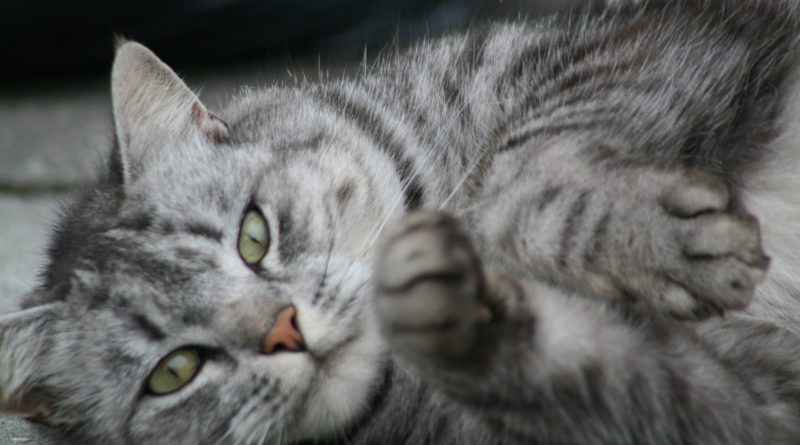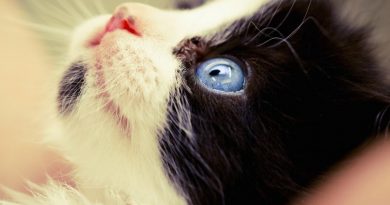FIV Feline Immunodeficiency Virus

This picture is of our original MadCat, Jack. He was a wonderful, intelligent cat, that unfortunately contracted Feline Immunodeficiency Virus at about 2 years old. I researched
The information on this page has been compiled from information given to me by my Vet from a veterinary information pack, and is medical fact not internet hearsay.
What is FIV?
Virologists classify feline immunodeficiency virus (FIV) in the same Retroviridae family as the Feline Leukemia Virus (FeLV), but with one major difference: FIV is not considered to be in the oncornavirus subfamily of retroviruses, as is FeLV. Instead, FIV is classified as a lentivirus (or “slow virus”), along with the viruses that cause acquired immunodeficiency syndrome (AIDS) in human beings. Lenti is from Latin, meaning slow because of the slow pathogenic process i.e. a long incubation period from infection to the exhibition of clinical signs.
How Prevalent is FIV?
The distribution of FIV is worldwide throughout the feline population with a staggering 22% of animals tested positive. Free–roaming male cats, especially aggressive ones – are the most frequently infected, while cats housed exclusively indoors are much less likely to be infected.
What is the Significance of FIV?
FIV in cats will eventually cause Immunodeficiency. This is like the human AIDS virus where the body loses it’s immune system. FIV is unable to survive outside of the body e.g. in saliva on food bowls or toys, and can only be passed from cat to cat. FIV is NOT passable onto humans.
Cats infected with FIV are infected for life, however it does not mean an immediate death sentence for your pet, many FIV positive cats live a long life. They may have frequent infections which can be treated, or they may go for a long period and show no signs of the illness. The only thing you must ensure is that an FIV positive cat is kept separated from other cats, so it can not pass the virus or pick up any secondary infections.
How is the virus spread?
The virus is mainly spread from bite wounds from an infected animal. It is more common in males than females, as males are more likely to fight and are therefore bitten more frequently. The virus is excreted in the saliva and is therefore passed through a bite from an infected animal. Passing of the virus from the mother to the kittens through the placenta is rare, unlike in the human HIV virus, this is presumably because of the different types of the placenta in cats and humans. Neonatal transmission (after birth) may occur when the queen (mother) licks her kittens or bites through the umbilical cord. It may also be passed from the queen in her milk. Sexual contact is not a primary means of spreading FIV.
How does the virus work?
Following initial infection, the virus is carried to regional lymph nodes, where it may replicate in white blood cells known as T–lymphocytes. The virus then spreads to lymph nodes throughout the body, resulting in a generalized enlargement of the nodes. This stage of the disease usually passes unnoticed by an owner unless the nodes are greatly enlarged. Some time later––perhaps days but usually weeks to months––the cat may develop a fever and a drop in the white blood cell count. This decrease in white cells is due primarily to a lack of neutrophils, the white blood cells that help protect cats against bacterial infections, and to a loss of certain types of lymphocytes called T–helper cells, which play an important role in almost every aspect of immune protection. Anaemia (or low red blood cell count ) also may develop, especially later in the disease. Persistently infected cats may appear normal for years. Eventually, signs of immunodeficiency begin to develop, and the cat’s ability to protect itself against infection is compromised. The same bacteria, viruses, protozoa, and fungi that are found in cats’ everyday environment––where they usually do not affect healthy animals––can cause severe illness in cats with weakened immune systems. These secondary infections are responsible for most of the clinical signs associated with FIV infection and are the major cause of death in FIV–positive cats.
The biological replication happens when the FIV virus binds to the host cell using the CD4 receptor and the cytokine CXCR4 receptor. The viral envelope fuses with the plasma membrane liberating the core into the cytoplasm. The RNA genome of the virus is then transcribed into a double-stranded DNA copy by the viral reverse transcriptase enzyme. This DNA copy migrates to the nucleus of the cells where it becomes integrated into cellular chromosomal DNA. This transcription of the provirus leads to the manufacture of the virus proteins. The whole virus particles bud from the cell membrane without killing the host cell.
Cats infected with FIV are infected for life.
What are the Signs of FIV?
Swollen lymph nodes for 4-6 weeks post infection. As the CD4 levels fall immunodeficiency ensures, therefore many clinical signs may be possible due to secondary infections. 5% of cats show neurological signs.
Common Illness’ to look out for
B Cell Lymphomas
Gingivitis – Infection and inflammation of the gums is present in about half of the cats infected with FIV
Stomatitis – Infection and inflammation of the mouth is present in about half of the cats infected with FIV
Chronic or recurrent infections of the skin, urinary bladder, and upper respiratory tract
Weight loss and fatigue
Abortion of kittens or other reproductive failures have been noted in infected queens
Some infected cats experience seizures, mental deterioration, and other neurologic disorders
How is the Virus Detected?
Diagnosis is based on the history, clinical signs, and results of an FIV antibody test. This test is performed by most commercial and university veterinary diagnostic laboratories, and also is available in kit form for use in private veterinary clinics. The presence of FIV antibody in “positive ” test results indicates that a cat is infected with FIV––probably for its lifetime––and thus is capable of transmitting the virus to other cats. Since false–positive test results can occur, positive results should be confirmed using a test with a different format. Occasionally, an FIV test is reported as equivocal or indeterminate. Retesting in 8 to 12 weeks usually results in either a positive or a negative result. However, a few cats will continue to have equivocal results, often because of some factor in the blood that interferes with the test.
Young kittens may have positive test results for 12 to 16 weeks after birth, without actually being infected with FIV, because of passive transfer of FIV antibodies from the mother. Only a small percentage of these kittens actually are or will become infected. For this reason, kittens with positive antibody tests must be retested when they are 6 to 8 months of age to determine their true infection status.
A negative test result indicates that antibodies directed against FIV have not been detected. In most cases, a negative test result means that the cat is not infected. However, it takes 8 to 12 weeks after infection (and sometimes even longer) before detectable levels of antibody appear. If the test is performed during this interval, inaccurate results might be obtained. Therefore, antibody–negative cats with either an unknown or a known exposure to FIV–infected cats should be retested about 8 to 12 weeks after their most recent exposure in order to allow adequate time for development of antibodies. (On very rare occasions, cats in the later stages of FIV infection may test negative because their immune systems are so compromised that they no longer produce antibodies.)
Countermeasures that can be taken
Via the Animal
Vaccination – there is currently no vaccination available for FIV
Regular vaccinations (boosters) for other conditions (Feline panleukopenia, cat flu, FeLV) should be continued as normal in the FIV cat as these can reduce the risk of other infections that can stress the immune system.
Neutering to reduce the chance of fighting and therefore the likelihood of FIV transmission.
Keep FIV positive cats indoors so that they are not a risk to other outdoor cats and so the FIV positive cat will not be exposed to pathogens carried by other cats.
Via the Environment
Prevent contact of infected cats with uninfected cats. Thus cats kept permanently indoors have no opportunity to become infected.
Get your cat blood tested to determine which cats are infected (positive) and which are not.
Cat Breeders, multi-cat households and catteries should insist on FIV-negative status before accepting any new cats to the environment. Since indirect transmission can not occur FIV positive cats may be boarded safely in veterinary surgery with no fear of transmission to other cats.
Elimination
All cats should be tested and FIV positive and negative cats should be separated.
Ask the shelter, rescue centre, breeder etc to test your new pet before you take it home. Kittens may show a false positive result up to 16 weeks of age due to maternal antibodies. These must be retested after 12 weeks.
Confirm any positive result by immunofluorescence or Western Blot (done by your Vet).
Retest any FIV negative cat after 12 weeks in case they were infected but not yet seropositive at the time of the original test.
Things to Look Out For / Precautions
If you are buying/ adopting a cat of any age, can you see the mother? Is the mother known? Is the origin of the litter known? Is the medical history of the cat known?
If the kitten is from a stray litter, it MAY be infected.
If you can see the mother, you can tell if it is good health. Check for a shiny coat and any bite markings or marks in the fur, bald patches and bad breath.
If you looking at an older cat, ask if there is any information on it’s past medical history and vet records if possible.
Always ask for the cat to be tested before you take it home with you.
Stray Cats in your area
If there are stray cats in your area, then it is highly likely that they may be infected. Get your cat blood tested as soon as possible.
Bites
If your cat is bitten or fights often then it may have been infected. It is a good idea to get the cat blood tested.
Infections
One of the first signs to an owner is that their cat is frequently getting infections and not responding to treatment. This is one of the first visible signs to the owner that there may be a serious problem with the health of your cat. This is how we discovered that our cats were infected. Ask your vet to blood test your pet.
Catteries
If you have a HIV positive cat you will no longer be able to put your cat in a public cattery. You must arrange with your vet for them to board your cat when you go on holiday. Catteries will not accept FIV positive cats as they may infect other boarders.
Diet
Make sure that your cat is fed on a good diet. Ask your vet for information on this. A protein rich diet is advised. We feed our cats on Hill’s Science Plan which our vet assures us is the best that we can give them. It is high in protein, which can help the cat’s immune system.
I want another cat, but I already have cats in my house, what do I do?
If you have a multi-cat household get the cat tested before you introduce it into your household. If you are buying a kitten, try to get on around 16 weeks old where it should give a true result to a blood test. If you are unsure of the test result keep the new cat separate from your other cats, until they can be retested.
FIV information taken from Vetsream Plc vetinary information on FIV
Updated 20th October 2018




